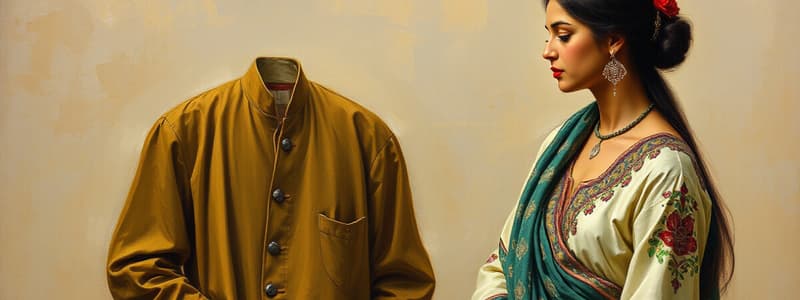Podcast
Questions and Answers
Which region in Pakistan is known for its traditional Ajrak and Sindhi topi?
Which region in Pakistan is known for its traditional Ajrak and Sindhi topi?
- Punjab
- Khyber Pakhtunkhwa
- Sindh (correct)
- Balochistan
What type of attire is popular among men in Balochistan?
What type of attire is popular among men in Balochistan?
- Tunic and jeans
- Sherwani
- Wide-legged trousers and long shirt (correct)
- Shalwar Kameez
What form of clothing is a Shalwar Kameez composed of?
What form of clothing is a Shalwar Kameez composed of?
- Loose trousers and long tunic (correct)
- Long skirt and fitted top
- Short tunic and fitted trousers
- Traditional gown and scarf
Which of the following is NOT typically associated with traditional Pakistani jewelry?
Which of the following is NOT typically associated with traditional Pakistani jewelry?
What modern trend has been observed in the fashion industry in Pakistan?
What modern trend has been observed in the fashion industry in Pakistan?
Flashcards are hidden until you start studying
Study Notes
Clothing and Attire in Pakistan
-
Traditional Clothing:
- Shalwar Kameez:
- Most common traditional outfit, worn by both men and women.
- Shalwar: loose trousers; Kameez: long tunic.
- Variations in style and fabric depending on region.
- Sherwani:
- Worn by men for formal occasions, especially weddings.
- Long coat-like garment, often embellished.
- Shalwar Kameez:
-
Regional Variations:
- Punjab:
- Brightly colored Shalwar Kameez, often with intricate embroidery.
- Women may also wear Dupatta (scarf).
- Sindh:
- Traditional Ajrak (block-printed shawls) and Sindhi topi (cap).
- Use of vibrant colors and patterns.
- Balochistan:
- Men wear wide-legged trousers and a long shirt.
- Women wear heavily embroidered dresses and shawls.
- Khyber Pakhtunkhwa:
- Men often wear a loose fitting Kameez with a turban.
- Women wear colorful outfits with distinctive embroidery.
- Punjab:
-
Contemporary Fashion:
- Influence of Western styles among younger generations.
- Fusion wear: Combination of traditional and modern attire.
- Popularity of designer brands and fashion shows.
-
Occasional Attire:
- Eid and Weddings:
- Special outfits, often heavily embellished.
- Use of luxury fabrics like silk and chiffon.
- Cultural Festivals:
- Traditional attire reflecting local customs and heritage.
- Eid and Weddings:
-
Accessories:
- Jewelry: Traditional gold and silver jewelry, including bangles and necklaces.
- Footwear: Kolhapuri sandals and Peshawari chappals are common for men; embellished sandals for women.
- Dupatta: Worn by women to complement traditional outfits, often used as a headscarf.
-
Cultural Significance:
- Clothing reflects social status, regional identity, and cultural heritage.
- Traditional attire is a symbol of pride and cultural continuity.
-
Modern Trends:
- Shift towards adopting sustainable and ethical fashion practices.
- Increased awareness and appreciation for artisanal craftsmanship.
Traditional Clothing
- Shalwar Kameez is the most prevalent traditional outfit in Pakistan, suitable for both genders.
- Shalwar refers to loose trousers, while Kameez indicates a long tunic, varying in style and fabric by region.
- Sherwani is a formal long coat worn by men, often embellished for events like weddings.
Regional Variations
-
Punjab:
- Known for brightly colored Shalwar Kameez with intricate embroidery.
- Women typically accessorize with a Dupatta, a decorative scarf.
-
Sindh:
- Features traditional Ajrak (block-printed shawls) and the Sindhi topi (cap).
- Prominent use of vibrant colors and elaborate patterns.
-
Balochistan:
- Men wear wide-legged trousers with a long shirt.
- Women adorn themselves in heavily embroidered dresses and shawls.
-
Khyber Pakhtunkhwa:
- Men often wear a loose, fitting Kameez accompanied by a turban.
- Women’s attire is colorful, showcasing distinctive embroidery.
Contemporary Fashion
- Younger generations are influenced by Western styles, leading to increased adoption of fusion wear that blends traditional and modern designs.
- Fashion shows and designer brands have gained popularity, indicating a modern evolution in clothing preferences.
Occasional Attire
- For festivals like Eid and weddings, special outfits are crafted, often featuring heavy embellishments and luxury fabrics, including silk and chiffon.
- Cultural festivals see participants wearing traditional attire that embodies local customs and heritage.
Accessories
- Jewelry plays a significant role, with traditional gold and silver pieces such as bangles and necklaces being popular.
- Footwear includes Kolhapuri sandals and Peshawari chappals for men, while women often wear embellished sandals.
- The Dupatta is a crucial accessory for women, serving as both a complement to clothes and a headscarf.
Cultural Significance
- Clothing in Pakistan serves as a marker of social status, regional identity, and cultural heritage.
- Traditional attire is a point of pride, symbolizing cultural continuity.
Modern Trends
- A noticeable shift towards sustainable and ethical fashion practices is emerging.
- There is growing appreciation for artisanal craftsmanship within modern clothing trends.
Studying That Suits You
Use AI to generate personalized quizzes and flashcards to suit your learning preferences.




